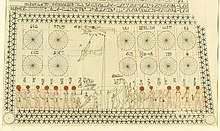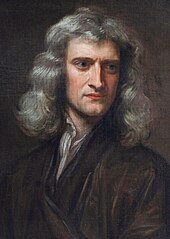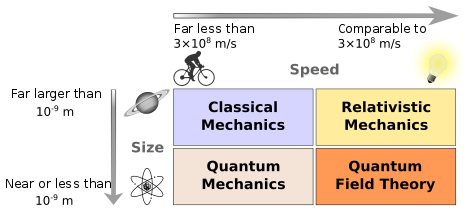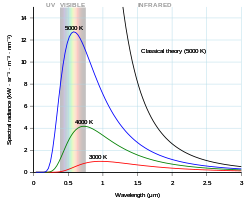History
Main article: History of physics
Ancient astronomy
Main article: History of astronomy
Astronomy is the oldest of the natural sciences. The earliest civilizations dating back to beyond 3000 BCE, such as the Sumerians, ancient Egyptians, and the Indus Valley Civilization, all had a predictive knowledge and a basic understanding of the motions of the Sun, Moon, and stars. The stars and planets were often a target of worship, believed to represent their gods. While the explanations for these phenomena were often unscientific and lacking in evidence, these early observations laid the foundation for later astronomy.[9]
According to Asger Aaboe, the origins of Western astronomy can be found in Mesopotamia, and all Western efforts in the exact sciencesare descended from late Babylonian astronomy.[10] Egyptian astronomers left monuments showing knowledge of the constellations and the motions of the celestial bodies,[11] while Greek poet Homer wrote of various celestial objects in his Iliad and Odyssey; later Greek astronomers provided names, which are still used today, for most constellations visible from the northern hemisphere.[12]
Natural philosophy
Main article: Natural philosophy
Natural philosophy has its origins in Greece during the Archaic period, (650 BCE – 480 BCE), when Pre-Socratic philosophers like Thales rejected non-naturalistic explanations for natural phenomena and proclaimed that every event had a natural cause.[13] They proposed ideas verified by reason and observation, and many of their hypotheses proved successful in experiment;[14] for example, atomism was found to be correct approximately 2000 years after it was first proposed by Leucippus and his pupil Democritus.[15]
Classical physics
Main article: Classical physics
Physics became a separate science when early modern Europeans used experimental and quantitative methods to discover what are now considered to be the laws of physics.[16]
Major developments in this period include the replacement of the geocentric model of the solar system with the helio-centric Copernican model, the laws governing the motion of planetary bodies determined by Johannes Kepler between 1609 and 1619, pioneering work on telescopes andobservational astronomy by Galileo Galilei in the 16th and 17th Centuries, and Isaac Newton's discovery and unification of the laws of motion anduniversal gravitation that would come to bear his name.[17] Newton also developed calculus,[c] the mathematical study of change, which provided new mathematical methods for solving physical problems.[18]
The discovery of new laws in thermodynamics, chemistry, and electromagnetics resulted from greater research efforts during the Industrial Revolution as energy needs increased.[19] The laws comprising classical physics remain very widely used for objects on everyday scales travelling at non-relativistic speeds, since they provide a very close approximation in such situations, and theories such as quantum mechanics and thetheory of relativity simplify to their classical equivalents at such scales. However, inaccuracies in classical mechanics for very small objects and very high velocities led to the development of modern physics in the 20th century.
Modern physics
From Wikipedia, the free encyclopedia
Modern physics is an effort to understand the underlying processes of the interactions of matter utilizing the tools of science & engineering. It implies that nineteenth century descriptions of phenomena are not sufficient to describe nature as observed with modern instruments. It is generally assumed that a consistent description of these observations will incorporate elements ofquantum mechanics & relativity.
Small velocities and large distances is usually the realm of classical physics. Modern physics often involves extreme conditions; in practice, quantum effects typically involve distances comparable toatoms (roughly 10−9 m), while relativistic effects typically involve velocities comparable to thespeed of light (roughly 108 m/s).[dubious ]
Overview[edit]
| Modern physics |
|---|
 |
| History of modern physics |
In a literal sense, the term modern physics, means up-to-date physics. In this sense, a significant portion of so-called classical physics is modern. However, since roughly 1890, new discoveries have caused significant paradigm shifts: the advent of quantum mechanics (QM), and of Einsteinian relativity (ER). Physics that incorporates elements of either QM or ER (or both) is said to bemodern physics. It is in this latter sense that the term is generally used.
Modern physics is often encountered when dealing with extreme conditions. Quantum mechanical effects tend to appear when dealing with "lows" (low temperatures, small distances), while relativistic effects tend to appear when dealing with "highs" (high velocities, large distances), the "middles" being classical behaviour. For example, when analysing the behaviour of a gas at room temperature, most phenomena will involve the (classical) Maxwell–Boltzmann distribution. However near absolute zero, the Maxwell–Boltzmann distribution fails to account for the observed behaviour of the gas, and the (modern) Fermi–Dirac or Bose–Einsteindistributions have to be used instead.
Very often, it is possible to find – or "retrieve" – the classical behaviour from the modern description by analysing the modern description at low speeds and large distances (by taking a limit, or by making an approximation). When doing so, the result is called the classical limit.
| “ | The term "modern physics," taken literally, means of course, the sum total of knowledge under the head of present-day physics. In this sense, the physics of 1890 is still modern; very few statements made in a good physics text of 1890 would need to be deleted today as untrue... On the other hand... there have been enormous advances in physics, and some of these advances have brought into question, or have directly contradicted, certain theories that had seemed to be strongly supported by the experimental evidence. For example, few, if any physicists in 1890 questioned the wave theory of light. Its triumphs over the old corpuscular theory seemed to be final and complete, particularly after the brilliant experiments of Hertz, in 1887, which demonstrated, beyond doubt, the fundamental soundness of Maxwell's electromagnetic theory of light. And yet... these very experiments of Hertz brought to light a new phenomenon—the photoelectric effect—which played an important part in establishing the quantum theory. The latter theory... is diametrically opposed to the wave theory of light; indeed, the reconciliation of these two theories... was one of the great problems of the first quarter of the twentieth century. |





